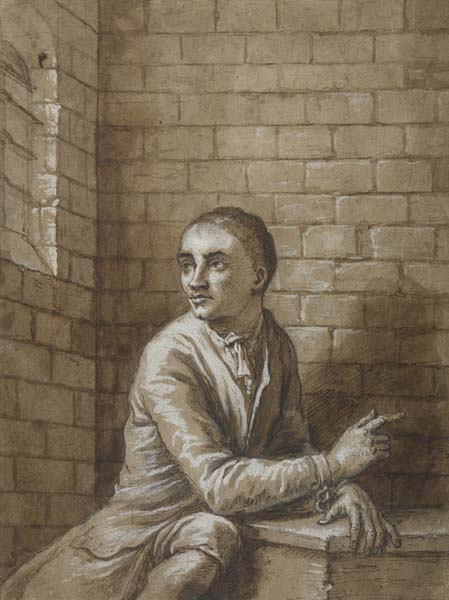John (Jack) Sheppard was a London thief who became notorious for his ingenious escapes from prison in the early 1720s.
Born in 1702 in White Row, Spitalfields Sheppard completing some basic schooling and worked as a servant before being apprenticed to a woollen draper in 1714. Although he was said to be a talented apprentice, Jack fell under the influence of the keeper of the Black Lion alehouse. Here in 1722 he met and fell in love with the prostitute Elizabeth Lyon, who is said to have induced him to become a thief.
Sheppard absconded from his master in August 1723 and drifted into a life of professional crime. He committed burglaries with his brother Thomas and Elizabeth Lyon, and was arrested for the first time in April 1724 and sent to the parish roundhouse of St Giles-in-the-Fields. From here he made his first escape by breaking a hole through the roof. Further arrests and escapes followed. On 25 May he and Elizabeth escaped from New Prison in Clerkenwell by sawing through his fetters, removing the bars from the window and descending 25 feet with a rope of knotted sheets and scaling a 22 foot wall. After committing further burglaries and highway robbery Sheppard was arrested on 23 July, brought to trial at the Old Bailey and sentenced to death.
He managed to escape twice more from Newgate prison: first by squeezing through his window and exiting the main door disguised in a nightgown, and then by climbing through a chimney, getting through the locks and bars of six strong doors and descending from the prison roof to the window of a neighbouring house. After burgling a pawnshop in Drury Lane Sheppard was arrested for a final time on 31 October. He was watched day and night by guards, who charged curious visitors to see the famous prison breaker, including the artist James Thornhill, whose drawing is in the Museum of London’s collection. On 16 November Sheppard was executed at Tyburn in front of a huge crowd.
Sheppard’s fame had great longevity as accounts of his exploits were published in pamphlets, ballads, engravings and plays. Most of the depictions in the Museum’s collection date from the mid-nineteenth century. They include numerous theatrical portraits (including Joseph Grimaldi playing the part) and a series of etchings by George Cruikshank for William Harrison Ainsworth’s best-selling romance, ‘Jack Sheppard’ (1839).








